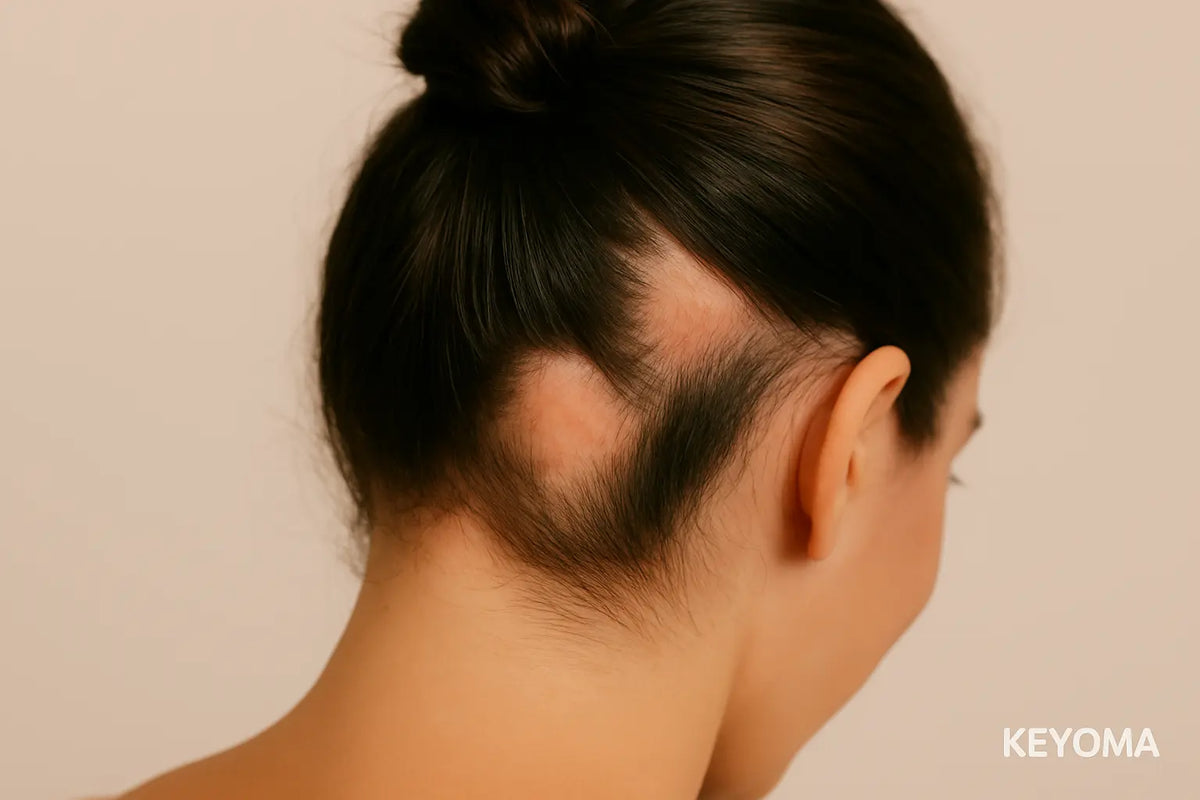In this article
Most people think hair loss is always reversible—that if you just find the right shampoo, serum, or supplement, your strands will bounce back. But there’s a lesser-known kind of hair loss that quietly challenges that belief: scarring alopecia.
In this guide, we’ll talk about what scarring alopecia is, what causes it, how to recognize the warning signs early, and what you can do to protect your scalp before the damage becomes permanent.
What Is Scarring Alopecia?
Scarring alopecia, also known as cicatricial alopecia, is a group of rare hair disorders where inflammation permanently destroys hair follicles and replaces them with scar tissue.
Once scarring occurs, the follicles can no longer produce new strands, leading to irreversible hair loss in the affected areas.
This inflammation can stem from the body’s immune response, chronic infections, or trauma (such as physical injuries, burns, harsh chemical treatments, or repeated traction from tight hairstyles) that damages the follicle’s structure.
While it can appear suddenly or develop slowly over time, the damage it causes is usually permanent if not treated early.
What Does Scarring Alopecia Look Like?
In its early stages, scarring alopecia usually appears as small patches of thinning hair that look smooth, shiny, or discolored in the affected areas, sometimes with visible loss of follicular openings.
In darker skin tones, the affected spots may appear lighter or darker than surrounding skin. In lighter tones, they may show a pinkish or whitish hue.
When the inflammation is active, redness, scaling, and pustules can appear around the hair shafts—a sign that the follicles are under attack.
Over time, the bald patches often merge into larger, irregular areas with no visible pores. The skin may feel tight or firm to the touch. Some people even describe mild itching or a burning sensation before permanent loss develops.
Can Hair Grow Back After Scarring?
When scarring is caught early, there’s still a chance to stop the inflammation before it destroys the follicles. In these cases, the follicles are only partially damaged, so some hair may still grow back.
Early treatments such as anti-inflammatory medications, topical steroids, or immune-modulating therapies can help calm the inflammation and stabilize the condition (more on treatments later).
However, once scar tissue fully replaces the follicles, natural regrowth becomes impossible since the damage blocks the follicle’s ability to produce new strands for good.
Scarring Alopecia Causes
Scarring alopecia can develop for several different reasons, but dermatologists generally divide its causes into two main categories: primary and secondary.
Primary Scarring Alopecia
Primary scarring alopecia is caused by autoimmune or chronic inflammatory conditions that attack the follicle’s base and surrounding tissue. The main types under this category include:
-
Central Centrifugal Cicatricial Alopecia (CCCA): Common among women of African descent, this form often begins at the crown and spreads outward in a circular pattern. It’s thought to be linked to genetic but can also be a result of repeated hair stress from tight styles or heat tools.
-
Chronic Cutaneous Lupus Erythematosus (CCLE): This type is caused by the autoimmune disease lupus erythematosus and leads to thick, scaly plaques that leave behind permanent scarring and pigment changes.
-
Folliculitis Decalvans: A bacterial-driven form characterized by pustules, crusting, and tufted hairs. Persistent infection triggers inflammation that gradually destroys surrounding follicles.
-
Lichen Planopilaris: The most common primary scarring alopecia, where T‑cells—immune cells meant to defend the body—attack follicular openings. It typically presents with itching, burning, and small patches of smooth baldness that may expand if untreated.
Each of these primary types leads to scarring once the inflammation has been active long enough to replace follicles with fibrous tissue.
Scarring Alopecia Early Signs & Symptoms
Because this condition can progress quietly, learning to spot early scarring alopecia symptoms gives you the best chance to prevent irreversible damage.
-
Hair loss: The first and most noticeable symptom. You may see small bald patches or thinning areas that gradually expand. The scalp in these spots often looks smooth and shiny rather than flaky, which hints that the follicles underneath are already inflamed or damaged.
-
Itching or burning: A persistent itchy or burning sensation on your scalp may appear before visible hair loss. This discomfort often signals active inflammation targeting the follicles.
-
Tenderness or pain: Some people describe mild pain or soreness in affected areas, particularly when touching or brushing their hair. This tenderness usually means inflammation is ongoing.
-
Redness or scaling: The scalp around active areas can appear red, scaly, or even develop small pustules. These are visible signs that the immune system is reacting.
-
Smooth, shiny patches: As scarring progresses, follicles close up and leave behind glossy patches with no visible pores. These areas indicate permanent follicle loss.
Scarring Alopecia Treatment Options
If you're wondering, Is there really a cure for scarring alopecia?, the honest answer is no. Once scar tissue replaces the follicles, there’s no way to fully restore them.
However, treatment can stop inflammation, slow progression, and preserve remaining follicles if the condition is caught early. Think of it as controlling the fire before it spreads.
Topical and Oral Anti-Inflammatories
Topical and oral anti-inflammatories are often considered the first line of defense for active scarring alopecia. Dermatologists often prescribe corticosteroid creams, gels, or injections to calm inflammation directly at the scalp.
For widespread or severe inflammation, oral medications like hydroxychloroquine, doxycycline, or short courses of prednisone may be used.
These work best in early to moderate stages, especially for autoimmune-driven types like lichen planopilaris or lupus-related alopecia.
Immunomodulators and Antibiotics
When inflammation stems from immune dysfunction or infection, your dermatologist may add medications that suppress or balance immune activity.
Topical calcineurin inhibitors (such as tacrolimus) can reduce immune aggression at the follicles.
For bacterial causes like folliculitis decalvans, long-term antibiotic therapy helps clear infection and reduce inflammation.
Platelet-Rich Plasma (PRP) and Growth-Stimulating Therapies
PRP injections are sometimes used in stable, early cases to stimulate hair density in partially damaged areas. While PRP won’t revive scarred follicles, it may strengthen surviving ones and improve scalp health.
Dermatologists often combine PRP with anti-inflammatory treatment for best results.
Hair Transplant Surgery
In advanced but inactive scarring alopecia, hair transplant surgery can restore cosmetic fullness. This option is only considered once inflammation has been fully inactive for at least a year, ensuring the grafts aren’t rejected or damaged.
It’s an ideal option for those who’ve achieved long-term stability through medication and care.
Supportive Scalp Care and Natural Options
Supportive scalp care remains one of the simplest yet most effective ways to help treat scarring alopecia and keep symptoms from worsening.
Remember that inflammation thrives on irritation and imbalance. And so, by keeping the scalp clean, hydrated, and protected, you reduce triggers that fuel follicular damage.
Moreover, a consistent routine also allows medicated treatments like corticosteroids or topical immunomodulators to work more efficiently, since buildup, excess oil, and tension no longer stand in the way of healing.
Below are core habits that directly support medical treatment and help protect surviving follicles:
-
Gentle cleansing: Use mild, sulfate-free shampoos to keep the scalp clean without stripping its natural barrier. A clean scalp limits bacterial buildup and supports topical treatments in controlling scarring alopecia.
-
Avoid tight hairstyles: Constant tension from braids, ponytails, or extensions can aggravate inflammation and worsen follicle stress. Looser styles reduce traction and protect the scalp from additional scarring.
-
Shield from heat and chemicals: Repeated exposure to hot tools, bleach, or harsh relaxers can irritate fragile follicles. Limiting these helps prevent flare-ups and keeps scarring alopecia from progressing.
-
Hydrate with natural oils: Lightweight nourishing oils such as batana, rosemary-infused, or castor oil blends can help calm irritation, restore comfort, and improve scalp elasticity. While they don’t reverse scars, they keep the scalp moisturized and create a healthier environment for remaining follicles.
-
Sun and environmental protection: Covering the scalp outdoors with a breathable hat or applying SPF-formulated sprays protects scarred skin from UV damage, which can worsen discoloration and sensitivity.
When Should I Consult a Dermatologist?
You should see a dermatologist as soon as you notice unusual or persistent scalp symptoms—even if they seem minor. This helps confirm whether scarring alopecia is developing quietly and allows you to take action before the damage becomes permanent.
The same applies if you’ve already tried home remedies or over-the-counter hair loss treatments without success. Scarring alopecia can’t be treated with cosmetic products alone. It requires medical management and a scalp-care plan tailored to your specific condition.
How common is scarring alopecia?
Scarring alopecia is relatively rare compared to non-scarring types of hair loss such as androgenetic alopecia or telogen effluvium. Dermatology studies estimate it makes up around 7% of all hair loss cases seen in clinics worldwide—that’s roughly 7 out of every 100 people dealing with hair loss.
While it can affect anyone, women between 30 and 60 years old—especially those of African or Afro-Caribbean descent—are most commonly affected. This is mainly due to the higher prevalence of a specific type called central centrifugal cicatricial alopecia (CCCA) within this group.
Can scarring alopecia be misdiagnosed?
Yes, scarring alopecia can easily be misdiagnosed, especially in its early stages. The symptoms often mimic other forms of hair loss such as seborrheic dermatitis, alopecia areata, or even fungal infections, mainly because early signs like mild redness, itching, and patchy thinning can look similar across different scalp conditions.
To accurately diagnose scarring alopecia, dermatologists typically perform a scalp biopsy, where a small tissue sample is examined under a microscope. This reveals whether inflammation is present around the follicles and whether scar tissue has started to form.
In some cases, trichoscopy (a magnified scalp examination) helps identify subtle changes like loss of follicular openings or perifollicular scaling.
Frequently Asked Questions
Is scarring alopecia contagious?
No, scarring alopecia is not contagious. You can’t catch it or pass it to anyone else through physical contact, sharing combs, towels, or even close interaction. That’s because it isn’t caused by bacteria, fungi, or parasites that spread from person to person.
Is scarring alopecia permanent?
In most cases, scarring alopecia is permanent—irreversible—once scar tissue has completely replaced the hair follicles. When that happens, the follicles lose their ability to regrow hair because their root structure is destroyed.
However, if treatment begins early while inflammation is still active but follicles are not yet fully scarred, some regrowth may still be possible.
Does minoxidil work on scarring alopecia?
Minoxidil may help in some cases of scarring alopecia, but its success depends on how much follicle damage has already occurred. In early or partially scarred areas where some follicles are still alive, it can support regrowth and make existing hair look thicker.
That said, if you're considering using it, it's best to do so under medical supervision. Your dermatologist can determine whether your scalp still has active follicles that can respond to the treatment.
Final Thoughts on Scarring Alopecias
Scarring alopecia may be rare, but for those affected, its impact can be deeply personal. Early recognition and prompt treatment can make all the difference between managing the condition and facing permanent hair loss.
If you found this guide helpful, explore the Keyoma Blog for more in‑depth articles like this one. From scalp care routines to natural hair‑nourishing ingredients, we’re here to help you keep your hair and scalp healthy for the long run.
Featured Product
100% Pure Batana Oil + Rosemary









